Integrating Teamwork Tools into CUSP Efforts
Slide Presentation
Slide 1

Integrating Teamwork Tools into CUSP Efforts
Shannon Davila, RN, MSN, CIC, CPQH
New Jersey Hospital Association
Slides adapted from original source:
Barbara Edson, RN, MBA, MHA
VP, Clinical Quality, Health Research & Educational Trust (HRET)
Slide 2
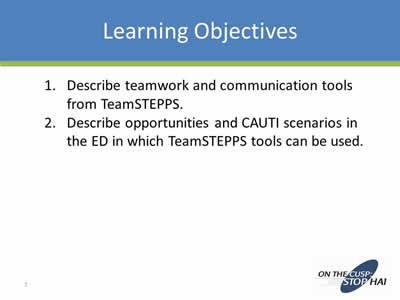
Learning Objectives
- Describe teamwork and communication tools from TeamSTEPPS.
- Describe opportunities and CAUTI scenarios in the ED in which TeamSTEPPS tools can be used.
Slide 3
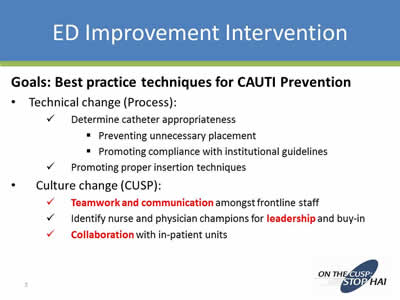
ED Improvement Intervention
Goals: Best practice techniques for CAUTI Prevention
- Technical change (Process):
- Determine catheter appropriateness
- Preventing unnecessary placement
- Promoting compliance with institutional guidelines
- Promoting proper insertion techniques
- Determine catheter appropriateness
- Culture change (CUSP):
- Teamwork and communication amongst frontline staff
- Identify nurse and physician champions for leadership and buy-in
- Collaboration with in-patient units
Slide 4
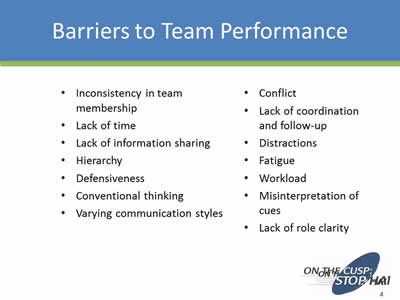
Barriers to Team Performance
- Inconsistency in team membership
- Lack of time
- Lack of information sharing
- Hierarchy
- Defensiveness
- Conventional thinking
- Varying communication styles
- Conflict
- Lack of coordination and follow-up
- Distractions
- Fatigue
- Workload
- Misinterpretation of cues
- Lack of role clarity
Slide 5
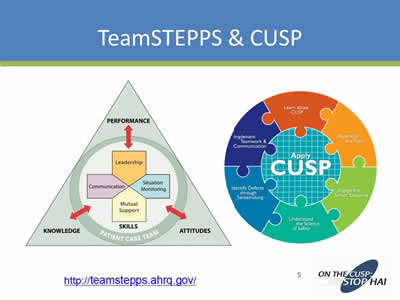
TeamSTEPPS & CUSP
Images: TeamSTEPPS and CUSP logos. Underneath the TeamSTEPPS logo is their url: http://teamstepps.ahrq.gov/
Slide 6
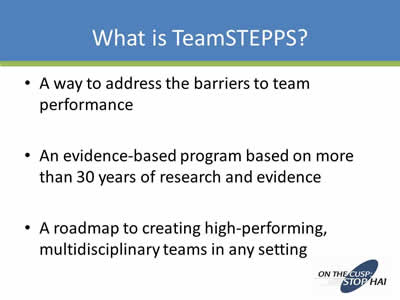
What is TeamSTEPPS?
- A way to address the barriers to team performance
- An evidence-based program based on more than 30 years of research and evidence
- A roadmap to creating high-performing, multidisciplinary teams in any setting
Slide 7
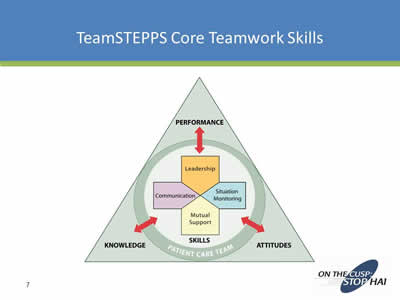
TeamSTEPPS Core Teamwork Skills
Image: TeamSTEPPS logo.
Slide 8
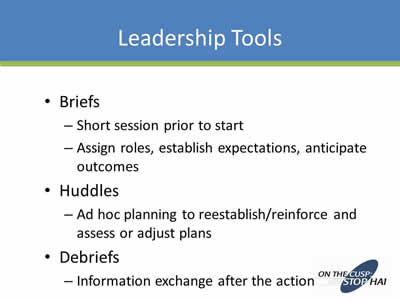
Leadership Tools
- Briefs:
- Short session prior to start
- Assign roles, establish expectations, anticipate outcomes
- Huddles:
- Ad hoc planning to reestablish/reinforce and assess or adjust plans
- Debriefs:
- Information exchange after the action
Slide 9
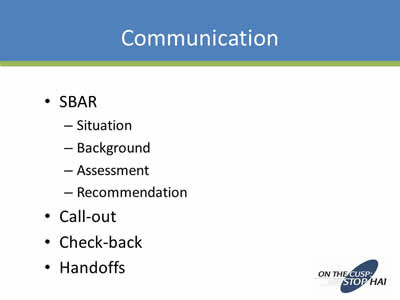
Communication
- SBAR:
- Situation
- Background
- Assessment
- Recommendation
- Call-out
- Check-back
- Handoffs
Slide 10
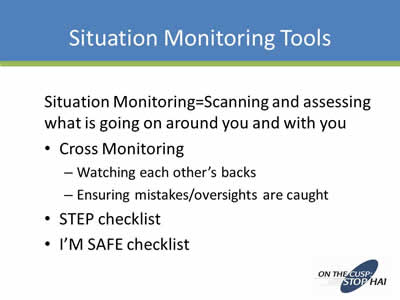
Situation Monitoring Tools
Situation Monitoring=Scanning and assessing what is going on around you and with you.
- Cross Monitoring:
- Watching each other’s backs
- Ensuring mistakes/oversights are caught
- STEP checklist
- I’M SAFE checklist
Slide 11

Mutual Support Tools
- Task Assistance=protecting each other from work overload
- Feedback
- Advocacy and Assertion
- Two-Challenge rule
- CUS (I’m Concerned, I’m Uncomfortable, This is a Safety Issue)
- DESC Script
- Collaboration
Slide 12
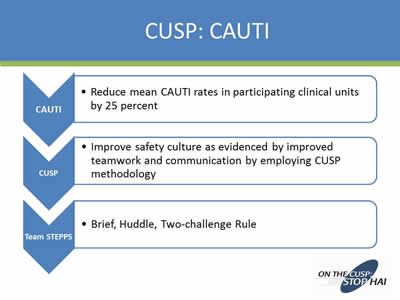
CUSP: CAUTI
CAUTI: Reduce mean CAUTI rates in participating clinical units by 25 percent
CUSP: Improve safety culture as evidenced by improved teamwork and communication by employing CUSP methodology
TeamSTEPPS: Brief, Huddle, Two-challenge Rule
Slide 13
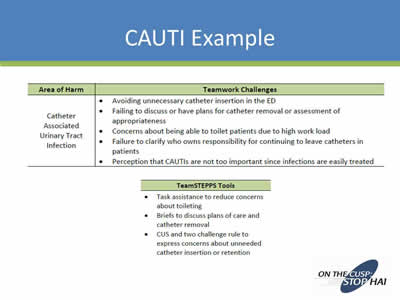
CAUTI Example
Area of Harm: Catheter Associated Urinary Tract Infection
Teamwork Challenges:
- Avoid unnecessary catheter insertion in the ED.
- Failing to discuss or have plans for catheter removal or assessment of appropriateness.
- Concerns about being able to toilet patients due to high work load.
- Failure to clarify who owns responsibility for continuing to leave catheters in patients.
- Perception tht CAUTIs are not too important since infections are easily treated.
TeamSTEPPS Tools
- Task assistance to reduce concerns about toileting.
- Briefs to discuss plans of care and catheter removal.
- CUS and two challenge rule to express concerns about unneeded catheter insertion or retention.
Slide 14
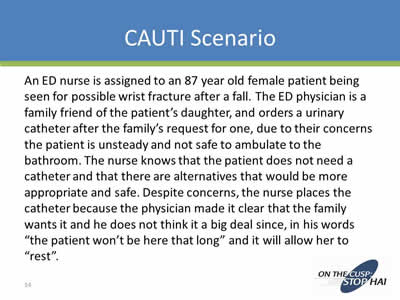
CAUTI Scenario
An ED nurse is assigned to an 87 year old female patient being seen for possible wrist fracture after a fall. The ED physician is a family friend of the patient’s daughter, and orders a urinary catheter after the family’s request for one, due to their concerns the patient is unsteady and not safe to ambulate to the bathroom. The nurse knows that the patient does not need a catheter and that there are alternatives that would be more appropriate and safe. Despite concerns, the nurse places the catheter because the physician made it clear that the family wants it and he does not think it a big deal since, in his words “the patient won’t be here that long” and it will allow her to “rest”.
Slide 15
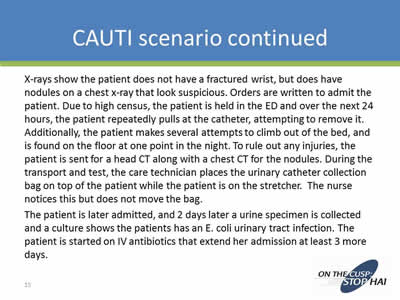
CAUTI Scenario continued
X-rays show the patient does not have a fractured wrist, but does have nodules on a chest x-ray that look suspicious. Orders are written to admit the patient. Due to high census, the patient is held in the ED and over the next 24 hours, the patient repeatedly pulls at the catheter, attempting to remove it. Additionally, the patient makes several attempts to climb out of the bed, and is found on the floor at one point in the night. To rule out any injuries, the patient is sent for a head CT along with a chest CT for the nodules. During the transport and test, the care technician places the urinary catheter collection bag on top of the patient while the patient is on the stretcher. The nurse notices this but does not move the bag.
The patient is later admitted, and 2 days later a urine specimen is collected and a culture shows the patients has an E. coli urinary tract infection. The patient is started on IV antibiotics that extend her admission at least 3 more days.
Slide 16
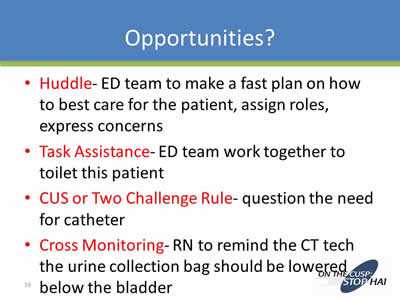
Opportunities?
- Huddle- ED team to make a fast plan on how to best care for the patient, assign roles, express concerns.
- Task Assistance- ED team work together to toilet this patient.
- CUS or Two Challenge Rule- question the need for catheter.
- Cross Monitoring- RN to remind the CT tech the urine collection bag should be lowered below the bladder
Slide 17
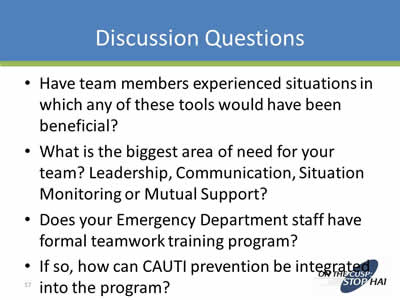
Discussion Questions
- Have team members experienced situations in which any of these tools would have been beneficial?
- What is the biggest area of need for your team? Leadership, Communication, Situation Monitoring or Mutual Support?
- Does your Emergency Department staff have formal teamwork training program?
- If so, how can CAUTI prevention be integrated into the program?
Slide 18

Slide 19
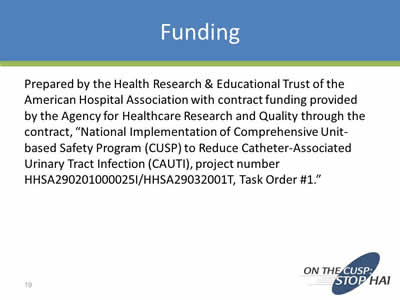
Funding
Prepared by the Health Research & Educational Trust of the American Hospital Association with contract funding provided by the Agency for Healthcare Research and Quality through the contract, “National Implementation of Comprehensive Unit-based Safety Program (CUSP) to Reduce Catheter-Associated Urinary Tract Infection (CAUTI), project number HHSA290201000025I/HHSA29032001T, Task Order #1.”
Return to CAUTI Toolkit Information for Specialty Audiences



